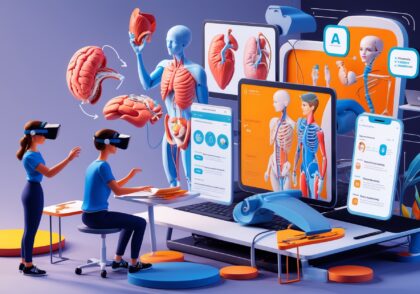The importance of combining anatomy and fun learning
Introduction
Anatomy, the study of the structure and function of the human body, is a key branch of biological and medical sciences. However, learning anatomy has always been a challenge for students and enthusiasts, as the information in this field is often complex and voluminous. Combining anatomy with edutainment is one of the best ways to facilitate learning, increase motivation, and create interest in this science. Fun learning, which means learning through fun, can turn anatomy into an engaging and memorable experience by using educational games, digital simulations, interactive videos, and other creative methods.
The importance of combining anatomy and fun learning
The challenges of learning anatomy the traditional way
Traditional methods of teaching anatomy typically involve reading textbooks, memorizing jargon, and viewing 2D models of the human body. This approach can be boring for many students and can lead to a loss of interest in learning.
Problems with learning anatomy the traditional way:
-
- High volume of information and complexity of specialized terminology
- Learning based on memorization without practical experience
- Lack of interaction and attractiveness in the educational process
Benefits of using fun learning in anatomy teaching
Integrating anatomy with fun learning can make learning more interactive and engaging. These methods can help improve understanding of concepts, increase motivation, and strengthen memory.
Benefits of learning anatomy in a fun way:
-
- Increase engagement and motivation to learn
- Strengthening memory through practical and interactive experiences
- Better understanding of anatomical structures through 3D images and models
Effective and fun ways to learn anatomy
Educational and digital games for learning anatomy
Digital games are one of the most effective ways to teach anatomy. They combine realistic images, animations, and educational challenges to help students better understand anatomical concepts.
Features of educational digital games:
-
-
- 3D simulation of the human body
- Interactive challenges and quizzes for better learning
- Possibility of repeated practice to increase mastery of concepts
-
Examples of digital anatomy games
| Game Name |
Features |
Educational Level |
| BioDigital Human |
3D body modeling and organ function visualization | Advanced |
| Anatomy Learning 3D |
Interactive experience with body structures | Intermediate |
| Visible Body |
Highly detailed anatomy display | Specialized |
Use interactive videos and 3D animations
Educational videos and 3D animations can explain complex anatomical concepts in a simple and engaging way. These methods are useful not only for students, but also for teachers and trainers.
Benefits of using educational videos:
-
- Explaining complex concepts visually and simply
- Increased ability to visualize and better understand body structure
- Ability to view the functioning of internal body organs in motion
Augmented Reality (AR) and Virtual Reality (VR) Simulations in Anatomy Education
Augmented reality (AR) and virtual reality (VR) are among the latest educational technologies that allow students to interact directly with anatomical models.
Features of AR and VR simulations:
-
- Possibility of examining the human body from different angles
- Direct interaction with 3D models
- Hands-on learning experience without the need for real-life samples
Comparison of anatomy teaching methods
| Educational Method |
Advantages |
Disadvantages |
| Traditional textbooks | Comprehensive and accurate information | Boring and non-interactive |
| Digital Games | Increasing Interactivity and Engagement | Needing Access to Digital Devices |
| VR and AR simulations | Hands-on and 3D experience | High cost |
The role of fun learning in teaching anatomy to different age groups
Fun anatomy learning for children
Children learn best through play and visual interaction. Using picture books, anatomical puzzles, and educational crafts can help them learn.
Effective methods of teaching anatomy to children:
-
- Picture books: Displaying body parts in a colorful and attractive way
- Anatomical Puzzles: Boosting Memory Through Brain Games
- Educational Crafts: Using Body Models for Hands-on Learning
anatomy edutainment for teens
Teenagers are more interested in practical and hands-on experiences. Using educational apps, hands-on experiments, and workshops can be engaging methods for this age group.
Effective methods of teaching anatomy to teenagers:
-
- Educational Apps: Learning Through Digital Programs
- Workshops: Hands-on learning experience with anatomical specimens
- Documentary videos: Presenting scientific information in the form of engaging visual content
The future of combining anatomy and fun learning
Technological advances in anatomy education
With the advancement of technology, new tools have been introduced for teaching anatomy that make learning this science easier and more engaging.
The future of anatomy education includes:
-
- Artificial intelligence to provide personalized training
- Developing more advanced applications for interactive learning
- Increasing access to virtual reality and augmented reality in schools and universities
The impact of fun learning on lifelong learning
Learning through play can maintain a lifelong interest in learning and ensure that learning is not limited to school.
Benefits of lifelong learning:
-
- Increased motivation for continuous learning
- Strengthening cognitive skills throughout life
- Using anatomical knowledge in everyday life
Conclusion
Combining anatomy with fun learning is an effective and engaging way to increase understanding and interest in this science. The use of educational games, interactive videos, 3D models, and augmented reality technologies can transform learning anatomy from a boring experience into an engaging and interactive activity. These methods can help children and adolescents gain a better understanding of the human body and ultimately, increase public health and awareness in society.






Leave a Reply
You must be logged in to post a comment.